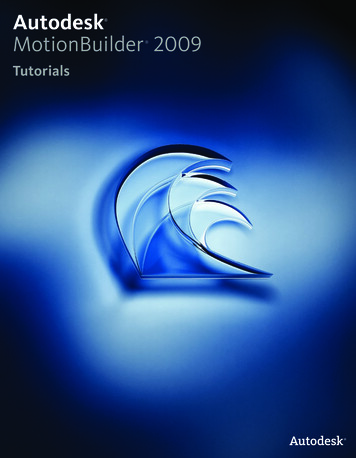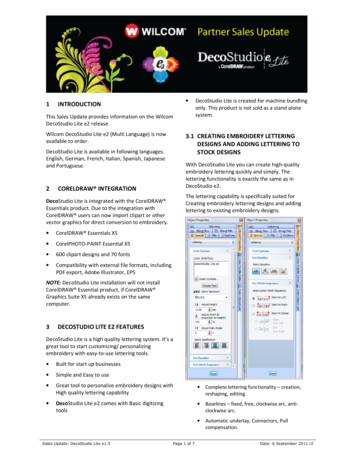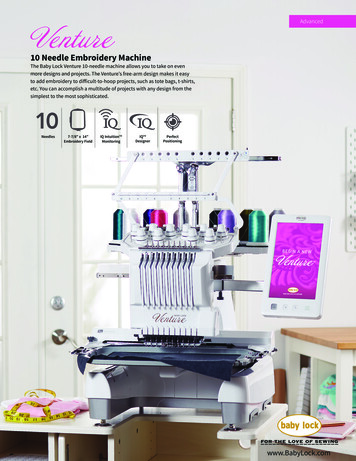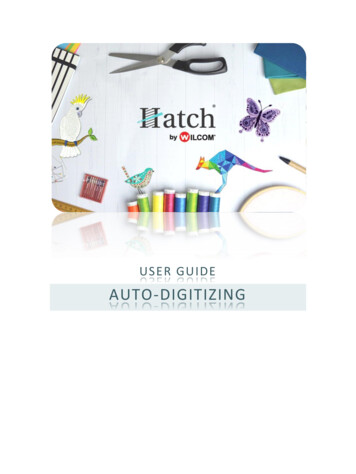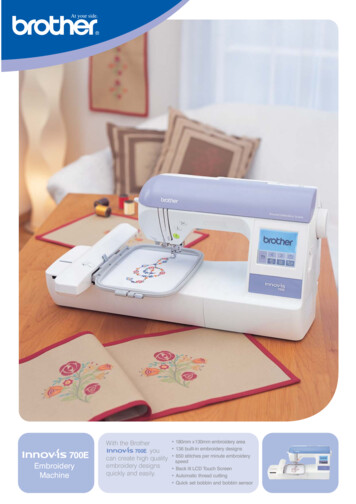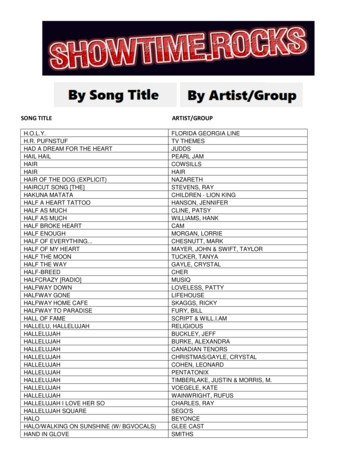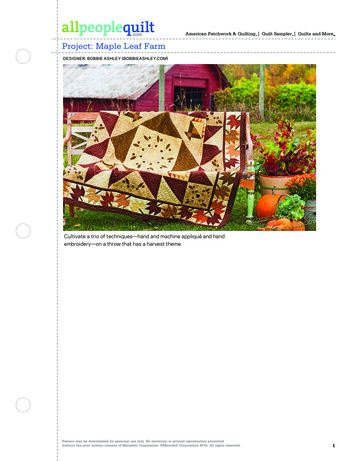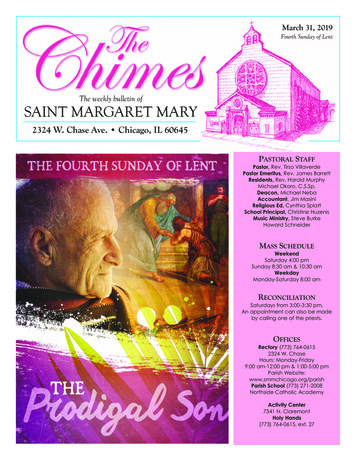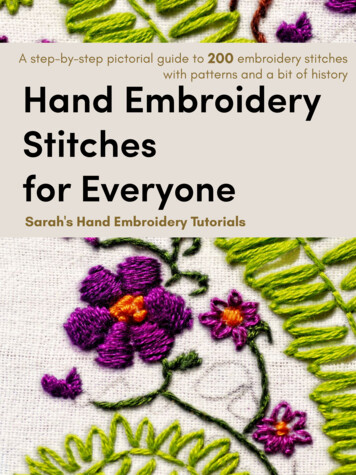
Transcription
A step-by-step pictorial guide to 200 embroidery stitcheswith patterns and a bit of historyHand EmbroideryStitchesfor EveryoneSarah's Hand Embroidery Tutorials
ContentsThis is a preview, buy the eBook fromSections In The Bookwww.embroidery.rocksea.org7Before You BeginFind all you need to know beforebeginning hand embroidery. Knowwhat tools and supplies you wouldneed and how to use them.31Picture IndexDon’t know the name of a stitch?The Picture Index will help you toidentify a stitch with the pictures.55Stitch TutorialsFind a treasure trove of 200 different stitches and a step-by-step guideto each stitch placed under differentfamilies.412PatternsFind printable patterns with stitchguidance for practice.Sprinkled here and there—tips, interesting facts, ideas to get creative, history, basicinformation on various embroideries, and samples contributed by some of our generous readers. Also, find an Index of Stitches in different categories in page 444.Sarah’s Hand Embroidery Tutorials5
ContentsBefore You BeginBefore You Begin08 Stitch Categories10 About Stitch Families11 Tools and Supplies13 More about Needles14 Some Tools to Draw and Transfer15 Making Patterns16 Tracing the Patterns17 Transferring the Patterns18 Hooping the Fabric19 Separating the Floss20 Threading the Needle21 Knotting the Thread24 Finishing with a Knot25 Picking Colors29 Some Good PracticesSarah’s Hand Embroidery Tutorials7
About Stitch FamiliesBefore You BeginThe Stitch FamiliesEmbroidery stitches can be dividedinto ‘families’ of stitches based on thesimilarities in their techniques. Sometimes, it becomes difficult to decidewhich family a stitch belongs to as itmight have characteristics from notonly more than one family, but also theaforementioned categories. So, suchstitches are assigned a family based onthe strongest characteristic it has. Forinstance, the ‘Knotted Chain BandStitch’ could be categorized as a member of the Knot Family. But, since ituses loops to create chains, we placedit under the Chain Stitch Family. Thisdoes not mean that it is strictly a member of the Chain Stitch, but only thatit shares a strong characteristic.The Stitch NamesOver time, certain stitches can get tobe known by different names. Whilemaking this book, we have tried tomention the alternate names wherever possible.Certain other times, two stitches canbe known by the same name! Thiscould be because of the resemblancethey have or just the way it got erroneously passed down. Another possibility is that different places usedthe same names to identify differentstitches. One such example is the‘Rice Stitch’ and the ‘Seed Stitch’,both of which are often used interchangeably. We have tried our bestto bring a clarity wherever possible.Sarah’s Hand Embroidery Tutorials10
Chain Stitch Family144 Chain Stitch148 Whipped Chain Stitch151 Back Stitched Chain152 Lazy Daisy156 Magic Chain Stitch157 Russian Chain Stitch158 Long Tailed Daisy161 Feathered Chain StitchSarah’s Hand Embroidery Tutorials149 Double Chain Stitch150 Interlaced Chain StitchCrystal, China163 Basque Stitch165 Petal Chain Stitch37
ContentsStitch TutorialsStitch Tutorials056 Straight Stitch Family72 Running Stitch Family106 Back Stitch Family118 Stem Stitch Family132 Chevron Stitch Family142 Chain Stitch Family195 Knots Family222 Palestrina Family230 Satin Stitch Family246 Fishbone Family254 Fly Stitch Family264 Feather Stitch Family274 Cretan Stitch Family282 Blanket Stitch Family316 Weave Family336 Herringbone Family379 Couching Family404 Cross Stitch FamilySarah’s Hand Embroidery Tutorials55
Herringbone Ladder Filling StitchAlso known asDifficulty levelStitch categoryUsed forYou need to know:::::Back Stitch FamilyInterlaced Band StitchIntermediateLine stitch, Straight stitch, Woven stitchDecorating, border designing, filling, even weave fabricBack StitchThis variation is done over two parallel rows of Back Stitches, but stepped to each other. Essentially, you are kind of making a Herringbone Stitch by weaving on the Back Stitch foundation,instead of the fabric directly. This explains the name, and it proves very decorative giving a rich look.Make a foundation with twoparallel rows of Back Stitches, stepping them. That is A liesbetween a-b, B lies between b-c, andso forth.1Bring out the needle fromone end of the bottom rowand slide the needle under the firststitches of both the rows, as shown.23456Turn around again, and passthe needle under the workingthread and the next stitch.Sarah’s Hand Embroidery TutorialsKeep up with this method tillthe end of the row.Turn around the needle andpass it under the workingthread and then b-c, as in thepicture.A finished section looks likethis and gives a netted effect.115
Russian Chain StitchDifficulty levelStitch categoryUsed forYou need to know::::Chain Stitch FamilyEasyLine stitch, Stand alone stitch, Looped stitchDecorating, border designingLazy Daisy, Chain StitchAs the name suggests, this stitch is found in Russian embroideries, usually along with the basicChain Stitch. It is made by grouping together three Lazy Daisy Stitches, in a clover shape. Ideally,the first Lazy Daisy loop would point upward, but working this stitch in the reverse order is easier.Let’s work on a vertical border, over three parallel stitch lines.1Begin by making the first loopas you would for Lazy Daisy.Come out from the second stitchline at a point A. Put the needleback in A and bring it out from B.Loop the thread around the needleand pull out the needle.2Now, make the second loopby putting the needle backin B and bringing it out from C,which lies at an angle on the firststitch line. Loop the thread aroundand pull the needle out to make thesecond loop.3Anchor down the second loopas you would in Lazy Daisy.Next, make the third Lazy Daisyloop, but this time towards the rightside, with D lying at an angle on thethird stitch line.Good to know.4Once finished, the clovershaped Russian Chain Stitchwould look like this. As mentionedbefore, this is in an upturnedposition. Ideally, it should pointupwards.Sarah’s Hand Embroidery Tutorials5A series of vertical RussianChain Stitches would showup like this (reverse order). You canchoose to close them in or spacethem out.When you make horizontal borders, The stitches areplaced one on the side of theother with the first Lazy Daisy pointing upwards. Whendoing a vertical border, theyall fall below one another, butagain with the first Lazy Daisypointing upward.Of course, I suggest a lenientapproach to using this stitch.157
SampleSatin Stitch FamilyContributed by:Savitri, IndiaStitches used:Brick StitchFrench KnotBlanket Stitch (outlining the leaves)Sarah’s Hand Embroidery Tutorials245
Kutch WorkThese Interlaced Maltese Crosses are usedin the Kutch Embroidery. Kutch is a region that lies on the northern part of a statecalled Gujarat in India. The word Kutch (orKuchchh) literally means something that becomes sporadically wet and dry. The languagespoken in Kutch is Kuchchhi, Gujarati andSindhi (not necessarily in equal ratios). TheKuchchi language has already lost its script toextinction and mostly uses the Gujarati scriptto express. Kuchchi language bears more similarity to Sindhi (again, another endangeredlanguage) than Gujarati. This is one reasonwhy this embroidery is also known as SindhiEmbroidery.Herringbone FamilyAfricaAsiaEuropeAustraliaThe region of Kutch is inhabited by groupsof people that had migrated from as near asthe neighboring state of Rajasthan to as faras Afghanistan. We would still be able to findmany nomadic and semi nomadic groups inthis part of the world. This might explain itssimilarity to the Armenian Marash Embroidery.Traditional Kutch Work PatternSarah’s Hand Embroidery TutorialsEach group or clan is distinguished by theKuchchi language they use. But there is another way of distinguishing these clans- bythe way their do their hand embroidery work.Some of them use mirrors along with theirhand embroidery, some others might have acertain type of embroidery stitch that they favor. But, all their embroideries are done withbright and vivid colored threads over a solidcolored background.375
This stitch is named after Elizabeth (Bessie) Burden, who was known to be fine atneedlework during the late 19th century. She was born in Oxford and taught atthe Royal School of Needlework, an institute that was started to revive the art ofneedlework. She was a model and muse, to the British textile designer, William Morris,whom she later married. Bessie taught students to work on pieces designed by him andother designers. She employed a variety of ‘cushion’ stitch from the medieval period. In thelate 19th century this stitch was called the ‘Tapestry Stitch’. She used it to cover large areas,especially the flesh tones of the figurines in the design. This stitch was renamed as ‘BurdenStitch’ by the school in recognition of Bessie’s contribution.
ContentsPatternsPatterns413Patterns - Stitched SamplesFind 5 stitch samples made to showthe how different stitches have beenused in a pattern. Think of what other stitches you would have used overthese patterns.418Bullion KnotsStem StitchSatin StitchCrested ChainStitchPatterns - With Stitch GuideFind 15 simple patterns which youcan draw directly over the fabric. Follow the guide to practice the stitches. Try your own choice of stitches ifyou like!433Patterns - PrintableFind 10 patterns you can either drawdirectly over the fabric or print andtransfer. Use your own imaginationto fill them with the stitches of yourchoice!Sarah’s Hand Embroidery Tutorials412
OrchidPatterns—with Stitch GuideColonial KnotsLong Tailed DaisyPekinese StitchBack StitchClosed Feather StitchLong Tailed DaisySatin StitchBack StitchPekinese StitchFrench KnotSarah’s Hand Embroidery TutorialsClosed Feather StitchSatin Stitch426
Index—Stitch Categories277 Closed Cretan Stitch208 Bullion Knot278 Laced Cretan Stitch211 Danish Knot279 Scottish Cretan Stitch215 Surrey Stitch281 Knotted Cretan Stitch216 Four Legged Knot283 Blanket Stitch217 Knotted Diamond Stitch287 Buttonhole Stitch223 Palestrina Stitch288 Whipped Buttonhole Stitch224 Sorbello Stitch289 Double Blanket Stitch225 Basque Knot291 Half-crossed Blanket Stitch226 Triple Palestrina Stitch292 Crossed Blanket Stitch227 Reversed Palestrina Stitch293 Buttonhole Wheel281 Knotted Cretan Stitch295 Buttonhole Wheel Cup301 Berwick Stitch296 Rosette of Thorns307 Knotted Blanket Stitch298 Buttonhole Bar Stitch308 Antwerp Edging stitch301 Berwick Stitch341 Tied Herringbone Stitch302 Barb Stitch303 Buttonhole Filling StitchWoven Stitches304 Detached Buttonhole Stitch69 Arrowhead Stitch Threaded305 Mirrored Blanket Stitch77 Looped Running Stitch306 German Knotted Blanket Stitch78 Laced Running Stitch307 Knotted Blanket Stitch82 Eskimo Laced Edging308 Antwerp Edging stitch83 Interlaced Running Stitch309 Blanket Stitch Honeycomb84 Whipped Running Stitch311 Fishnet Stitch87 Parallel Running Stitch variations312 Blanket Stitch Scallops90 Stepped Running Stitch variations314 Shaped Blanket Stitch Scallops111 Pekinese Stitch315 Buttonhole Shading Stitch112 Threaded Back Stitch114 Whipped Back StitchKnotted Stitches115 Herringbone Ladder Filling Stitch193 Knotted Chain Band122 Whipped Stem Stitch196 French Knot137 Threaded Chevron198 Pistil Knot148 Whipped Chain Stitch200 Colonial Knot150 Interlaced Chain Stitch202 Coral Stitch190 Butterfly Chain Stitch203 Scroll Stitch191 Raised Chain Band205 Chinese Knot192 Checkered Chain BandSarah’s Hand Embroidery Tutorials446
Index—Stitch CategoriesFrom our readers“I hadn’t worked on the Bullion Knot in years! And you know, Ihaven’t worked it better than ever now. I can do it practicallywith my eyes closed. I was greatly relieved and thankful tofind these hand embroidery tutorials you’ve made. It is thebest! Simple, well illustrated, viola that’s it!” — Kristin, 2019“It is so helpful and put together beautifully. It’s really betterthan all the embroidery books I’ve ever looked at” — Tipton, 2018“This was fantastic for my homework for sewing. Definitely, highlyrecommended. I would mostly recommend this for students” — Kitty, 2017“A proper treasure trove of stitches and tutorials” — Elly, 2016“It is well presented and the instructions are facile for any level of handcrafter” — Dr. Carla, 2015“I’ve been embroidering for almost 40 years, but I’m German, and forthe names of most of the stitches I don’t know the English equivalent.Your picture dictionary approach is really helpful!” — Maria, 2014“I started doing embroidery about 50 years ago but hadput it aside for the last 20. I just picked it back up and thisis exactly what I needed to get me excited about the craft.You have an incredible amount of information and the basicStitch Family is exactly what I needed” — MaryAnne, 2013“It’s the most clear tutorial ever, and its easy to understand for anybeginner” — Maureen, 2012“I am fascinated by your knowledge, and your excellent instructions!I’m beginning hand embroidery and am so thrilled that this resource isavailable” — Catherine, 2011“I have just started a quilting project that includes hand embroidery. Yourtutorials are great just like having a teacher in the room with me. I amleft-handed so I appreciate seeing the stitches so clearly. Thank you,Teacher” — Roseanna, 2010Follow us atSarah’s Hand Embroidery TutorialsThis is a preview, buy the eBook fromwww.embroidery.rocksea.org452
French Knot Blanket Stitch (outlining the leaves) Herringbone Family Sarah’s Hand Embroidery Tutorials 375 Kutch Work These Interlaced Maltese Crosses are used in the Kutch Embroidery. Kutch is a re-gion that lies
